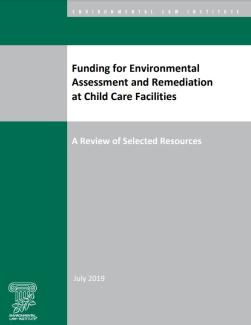
Environmental site hazards at a child care facility may arise from contamination of the air, soil, or water caused by historical uses of the property or nearby activities. Identifying and remedying such hazards is important for limiting harmful indoor and outdoor exposures to children and staff. The costs involved, however, can present challenges for child care operators, especially those serving historically underserved communities.
This report describes funding sources available as of 2019 that could potentially be tapped to help child care programs address environmental site hazards. The report focuses on resources for addressing issues such as contamination of playground soil and drinking water wells, as well as indoor vapor intrusion. Most of the highlighted funding sources, however, have a broader scope and might also be available to address other IAQ issues such as lead, asbestos, or radon contamination.
Although the report focuses on programs that are relevant to many states, it is not an exhaustive overview or compilation of funding sources and does not discuss federal and state superfund and brownfields programs.
Overview of the Report
The report describes federal, state, and non-governmental funding programs that span the areas of health, environment, early care and education, and economic development.
Federal Funding Programs. The Child Care and Development Fund program (Department of Health and Human Services) is the primary federal funding source devoted to supporting affordable child care for families with low incomes and to increasing the quality of child care for all children. The Community Development Block Grant program (U.S. Department of Housing and Urban Development) is the largest source of federal funding for community development activities such as rehabilitation of buildings. These two programs operate in every state and have detailed rules governing use of the funds.
State Funding Programs. States operate a wide array of programs that provide financial assistance to individuals, organizations, and businesses. In particular, many states have funding programs in the areas of site assessment and remediation, child care, and general home repairs that are potential funding sources if site contamination or other environmental hazards are identified at a particular child care facility.
Non-Governmental Funding Programs. There are many non-governmental funding programs whose missions might encompass child care facility health and safety improvements. The report describes the potential for tapping community development financing and philanthropic grantmaking to assist child care facilities in improving the early education environment by reducing harmful environmental exposures.
An appendix provides links to the federal and state programs highlighted in the report. Each of the funding sources described here presents some limitations – e.g., limits on dollar amounts available or on the types of child care facilities that are eligible – but they are can be a starting point for states seeking to identify resources for environmental assessment and remediation at child care facilities.
Explore other materials from ELI’s Indoor Environments Program.
© Environmental Law Institute®